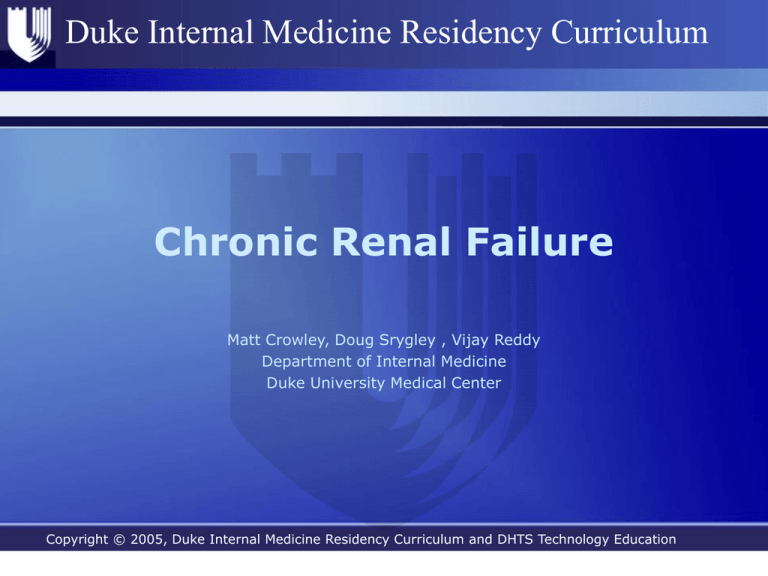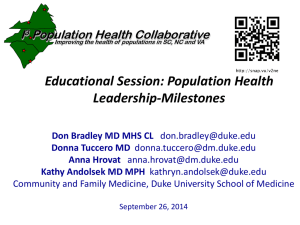
Duke Internal Medicine Residency Curriculum
Chronic Renal Failure
Matt Crowley, Doug Srygley , Vijay Reddy
Department of Internal Medicine
Duke University Medical Center
Copyright © 2005, Duke Internal Medicine Residency Curriculum and DHTS Technology Education
Duke Internal Medicine Residency Curriculum
Introduction
•
•
•
•
•
•
•
•
•
•
Definitions
Classifications
Epidemiology
Causes/Risk factors
Natural history
Complications
Screening
Diagnosis
Management
Self-Assessment Questions
Copyright © 2005, Duke Internal Medicine Residency Curriculum and DHTS Technology Education
Services
Duke Internal Medicine Residency Curriculum
Definitions
• National Kidney Foundation - Kidney Disease Outcomes
Quality Initiative (NKF-K/DOQI) workgroup has defined
chronic kidney disease (CKD) as the following:
– The presence of markers of kidney damage for 3 months, as
defined by structural or functional abnormalities of the
kidney with or without decreased glomerular filtration rate
(GFR), manifest by either pathological abnormalities or other
markers of kidney damage, including abnormalities in the
composition of blood or urine, or abnormalities in imaging
tests
OR
– The presence of GFR <60 mL/min/1.73 m2 for 3 months,
with or without other signs of kidney damage as described
above.
Copyright © 2005, Duke Internal Medicine Residency Curriculum and DHTS Technology Education
Services
Duke Internal Medicine Residency Curriculum
Classifications
According to a National Health and Nutrition Examination Survey
(NHANES):
• Stage 1 disease is defined by a normal GFR (greater than 90
mL/min per 1.73 m2) and persistent albuminuria
– 2.8 % of the total United States population
• Stage 2 disease is a GFR between 60 to 89 mL/min per 1.73 m2 and
persistent albuminuria
– 2.8 % of the U.S. population
• Stage 3 disease is a GFR between 30 and 59 mL/min per 1.73 m2
– 3.7 % of the U.S. population
• Stage 4 disease is a GFR between 15 and 29 mL/min per 1.73 m2
– 0.13 % of the U.S. population
• Stage 5 disease is a GFR of less than 15 mL/min per 1.73 m2 or
end-stage renal disease
– Approximately 0.2 % of the U.S. population
– Increasing at a faster rate than other stages!
Copyright © 2005, Duke Internal Medicine Residency Curriculum and DHTS Technology Education
Services
Duke Internal Medicine Residency Curriculum
Epidemiology
• There are important racial/ethnic differences in the incidence
and prevalence of CKD in the U.S.
– 256 per million population in Caucasians
– 982 per million in African Americans
– 344 per million in Asian Americans and native Hawaiians and
other Pacific Islanders
– 514 per million in American Indians and Alaska Natives
• African Americans have a disproportionately higher incidence
rate of ESRD due to diabetes and glomerulonephritis compared
to Caucasians.
• African Americans and Hispanics tend to reach ESRD at a
younger age than Caucasians (mean age 57 and 58 years,
compared to 63 years).
Copyright © 2005, Duke Internal Medicine Residency Curriculum and DHTS Technology Education
Services
Duke Internal Medicine Residency Curriculum
Causes/Risk Factors
Etiologies:
• Diabetes - type 1 and 2
• Glomerular disease - Autoimmune diseases,
systemic infections, drugs, neoplasia
• Vascular disease - Hypertension, large vessel
disease, microangiopathy
• Tubulointerstitial disease - UTI, stones,
obstruction
• Cystic kidneys - Polycystic Kidney Disease
Copyright © 2005, Duke Internal Medicine Residency Curriculum and DHTS Technology Education
Services
Duke Internal Medicine Residency Curriculum
Causes/Risk Factors
Risk factors for development of CKD:
•
•
•
•
Diabetes Mellitus
Hypertension
Cardiovascular disease
Family History of ESRD - even if you control
for other risk factors
• PCKD
• Low Birth Weight - possible risk factor
• Age
Copyright © 2005, Duke Internal Medicine Residency Curriculum and DHTS Technology Education
Services
Duke Internal Medicine Residency Curriculum
Causes/Risk Factors
Diabetic Nephropathy:
• Most common etiology of CKD
• Accounts for around 50% of ESRD
• Studies in type I patients indicate between
25-45% of patients develop ESRD
• Pathology
• Mesangial expansion
• GBM thickening
• Glomerular sclerosis
Copyright © 2005, Duke Internal Medicine Residency Curriculum and DHTS Technology Education
Services
Duke Internal Medicine Residency Curriculum
Causes/Risk Factors
Hypertension:
• Second most common cause of ESRD
• Accounts for estimated 23% of ESRD
between 1996-2000
• Pathology-progressive glomerulosclerosis and
subsequent worsening of renal function
• MRFIT trial shows odds ratio for development
of ESRD to normotensives
- Mild HTN=3.1, Mod=6.2, severe==11
Copyright © 2005, Duke Internal Medicine Residency Curriculum and DHTS Technology Education
Services
Duke Internal Medicine Residency Curriculum
Causes/Risk Factors
Risk factors for progression of CKD to ESRD:
• Hyperlipidemia - meta-analysis showed a slight decrease in
GFR with lipid lowering agent
• Low HDL
• HTN
• High protein diet - Protein restriction studies show about 0.5
yearly difference in GFR compared to control
• Increased proteinuria
• Obesity - observational data
• African-Americans - slightly less stage I and II CKD, but
greatly increased ESRD up to 5X
• Poverty
• Location - ESRD more common in Southern states
• Male sex
Copyright © 2005, Duke Internal Medicine Residency Curriculum and DHTS Technology Education
Services
Duke Internal Medicine Residency Curriculum
Natural History
• Initial insult patient-dependent - lupus, HTN,
etc.
• Kidney responds by adaptive hyperfiltration
of undamaged nephrons - beneficial
• Adaptive hyperfiltration - eventually leads to
damage of these nephrons
• Proteinuria results with subsequent decrease
GFR
• Usually asymptomatic at start of process
Copyright © 2005, Duke Internal Medicine Residency Curriculum and DHTS Technology Education
Services
Duke Internal Medicine Residency Curriculum
Natural History
Progression:
• NHANES data show different rates of
progression to renal replacement therapy
based on stage of disease
• In five years
• 1.1 % of stage II will progress to renal replacement
• 1.3 % of stage III will progress to RR
• 19.9% of stage IV will progress to RR
Copyright © 2005, Duke Internal Medicine Residency Curriculum and DHTS Technology Education
Services
Duke Internal Medicine Residency Curriculum
Complications
• Hypertension
• Anemia - decreased EPO production
• Volume overload
• Metabolic abnormalities – Acidosis,
hyperkalemia, hyperphosphatemia
• Renal Osteodystrophy
• Dyslipidemia
• Malnutrition
Copyright © 2005, Duke Internal Medicine Residency Curriculum and DHTS Technology Education
Services
Duke Internal Medicine Residency Curriculum
Screening
• CKD is worth screening for because it can be detected
early, and if identified, can be treated to reduce
progression to ESRD – however, because CKD is relatively
rare, screening of the general population is not currently
recommended.
• NKF-K/DOQI guidelines for CKD recommend that all
individuals should be assessed, as part of routine health
examinations, to determine whether they are at increased
risk for developing CKD.
Copyright © 2005, Duke Internal Medicine Residency Curriculum and DHTS Technology Education
Services
Duke Internal Medicine Residency Curriculum
Screening
• Screening for CKD can be simply done in higher-risk
patients with a:
– a urinalysis
– a "spot" urine sample for protein (or if the pt is felt to be of
particularly high risk, albumin) and creatinine assessment,
and
– a serum creatinine level.
• See the K/DOQI clinical practice guidelines for chronic
kidney disease for screening recommendations in various
subgroups. [6]
Copyright © 2005, Duke Internal Medicine Residency Curriculum and DHTS Technology Education
Services
Duke Internal Medicine Residency Curriculum
Diagnosis - General
Diagnosis
In general:
• Serum creatinine to estimate GFR
• Protein:Creatinine ratio or Albumin:Creatinine ratio in a
first morning urine specimen
• Examination of urine sediment or urine dipstick for red
and white blood cells
• Imaging
Copyright © 2005, Duke Internal Medicine Residency Curriculum and DHTS Technology Education
Services
Duke Internal Medicine Residency Curriculum
Diagnosis
Protein Quantification:
• Spot Protein:Creatinine ratio – representative of daily
protein excretion in grams. Ex. 240mg protein and 82mg
creatinine = 2.9g protein/day.
– May use albumin rather than creatinine provided proteinuria
is primarily albumin
– First morning collection preferred as it best represents 24
hours protein excretion
• 24 hour protein collection (gold standard)
– Hard for ambulatory patients
– Creatinine obtained as well to assess for adequacy of
collection
Copyright © 2005, Duke Internal Medicine Residency Curriculum and DHTS Technology Education
Services
Duke Internal Medicine Residency Curriculum
Diagnosis
Urinalysis:
• Cheap, Fast, Easy, and.. Fun?
• Yes, it needs to be spun and yes, a centrifuge is hard to find
• Casts
–
–
–
–
Red cell – glomerular disease such as DM
White cell - tubulointerstitial disease or acute pyelonephritis
Epithelial cell (muddy brown) – ATN and acute glomerulonephritis
Fatty – nephrotic syndrome
• Protein – Albumin, (+) after >300-500mg/day
• Bland – no casts, few cells, no protein more suggestive of
interstitial or vascular disease
Copyright © 2005, Duke Internal Medicine Residency Curriculum and DHTS Technology Education
Services
Duke Internal Medicine Residency Curriculum
Diagnosis
Imaging:
• Renal Ultrasound – safe, easy
– Exclude urinary tract obstruction
– Polycystic kidney disease
– Increased cortical echogenicity and decreased overall kidney
size indicative of “medical renal disease” – irreversible
• CT scan
– Mainly to distinguish a simple cyst from neoplastic lesion
– Renal stones (non-contrast)
• MRI
– Renovascular dz, RCC, contrast contraindicated
Copyright © 2005, Duke Internal Medicine Residency Curriculum and DHTS Technology Education
Services
Duke Internal Medicine Residency Curriculum
Diagnosis
Renal Biopsy:
• Indications vary: reversible vs. irreversible dz., persistent
hematuria with rising creatinine, nephrotic syndrome
(lupus nephritis), unknown etiology, transplanted kidneys
• Check labs: coags, Hct, T+S
• Avoided in severe HTN, bleeding disorders
• Tissue examined under light, immunofluorescence, and
electron microscopy
Copyright © 2005, Duke Internal Medicine Residency Curriculum and DHTS Technology Education
Services
Duke Internal Medicine Residency Curriculum
Management
Reversible causes to rule out:
•
•
•
•
•
Hypovolemia
Hypotension (sepsis)
Drugs – aminoglycosides, NSAIDS, contrast
Urinary tract obstruction – prostate
Renal artery stenosis
Copyright © 2005, Duke Internal Medicine Residency Curriculum and DHTS Technology Education
Services
Duke Internal Medicine Residency Curriculum
Management
Antihypertensive therapy:
• <130/85 minimum goal
• <125/75 in those with proteinuria>1 gm/day
• ACE inhibitors most “renoprotective” - reduce
intraglomerular pressure resulting in decreased protein
excretion
• ARBs as effective as ACE inhibitors in reducing proteinuria
• In general a reduction in both blood pressure AND
proteinuria results in preservation of renal function
Copyright © 2005, Duke Internal Medicine Residency Curriculum and DHTS Technology Education
Services
Duke Internal Medicine Residency Curriculum
Management
Glycemic control:
• Intensive insulin therapy thought to reverse the early
glomerular hyperfiltration and hypertrophy that are
thought to be important risk factors for glomerular injury
• Delays development of microalbuminuria
• Stabilize or decrease protein excretion in patient w/
microalbuminuria
• May not slow the rate of renal injury once overt
proteinuria has developed
Copyright © 2005, Duke Internal Medicine Residency Curriculum and DHTS Technology Education
Services
Duke Internal Medicine Residency Curriculum
Management
Complications:
• Anemia (erythropoeitin deficiency)
– Target Hgb 11-12g/dl
– Rule out absolute iron deficiency first (ferritin conc.
<100ng/ml and Iron Sat <20%)
– EPO 80-120U/kg SQ weekly – 2-4 doses
• Metabolic acidosis
– Tx. For arterial pH<7.25, serum bicarbonate<22
– NaHCO3 (0.5-1 meq/kg/day)
– Avoid citrate as this may precipitate aluminum toxicity
Copyright © 2005, Duke Internal Medicine Residency Curriculum and DHTS Technology Education
Services
Duke Internal Medicine Residency Curriculum
Management
Complications:
• Hypocalcemia / Hyperphosphatemia
• Serum calcium x phosphate product should be less than
50-55
• Phosphate levels between 2.7- 4.6 in CKD stage 3, 4 and
3.5-5.5 in ESRD
• In general for phosphorous binders:
– calcium acetate for low/normal calcium
– Sevelamer for high/normal calcium
– Use both for persistently elevated phosphate levels
Copyright © 2005, Duke Internal Medicine Residency Curriculum and DHTS Technology Education
Services
Duke Internal Medicine Residency Curriculum
Management
ESRD options:
• Hemodialysis – by far most common in U.S
• Peritoneal dialysis
– Generally for the more compliant patient
– Needs to still make urine for volume maintenance
• Kidney transplant
– Preferred for younger patients
– Living related>living unrelated>cadaveric
Copyright © 2005, Duke Internal Medicine Residency Curriculum and DHTS Technology Education
Services
Duke Internal Medicine Residency Curriculum
Management
Renal replacement therapy:
• Acute indications: A, E, I, O, U
• Indications in CKD: (not absolute)
–
–
–
–
–
–
–
GFR < 10-15 ml/min
Fluid overload refractory to diuretics
Uremia (BUN>100) – N,V
Pericarditis
Poorly controlled HTN
Pericarditis
Malnutrition?
• Access
– AV fistula – least infectious risk / other complications
– AV graft – (PTFE) – matures in weeks
– Tunneled Catheter – lower flows, higher rates of infection
Copyright © 2005, Duke Internal Medicine Residency Curriculum and DHTS Technology Education
Services
Duke Internal Medicine Residency Curriculum
Self-Assessment Questions
(see last slide for answers)
1. According to the NKF-K/DOQI workgroup, CKD is defined
by a GFR of:
A.
B.
C.
D.
E.
<
<
<
<
<
20 mL/min/1.73 m2
40 mL/min/1.73 m2
60 mL/min/1.73 m2
80 mL/min/1.73 m2
100 mL/min/1.73 m2
Copyright © 2005, Duke Internal Medicine Residency Curriculum and DHTS Technology Education
Services
Duke Internal Medicine Residency Curriculum
Self-Assessment Questions
2. Which of the following U.S. racial/ethnic groups has
higher-than-average incidence/prevalence of CKD:
A.
B.
C.
D.
E.
Caucasians
African-Americans
Asian-Americans
American Indians
Everyone except Caucasians
Copyright © 2005, Duke Internal Medicine Residency Curriculum and DHTS Technology Education
Services
Duke Internal Medicine Residency Curriculum
Self-Assessment Questions
3. Which out of the following is not a risk factor for
progression of CKD
A.
B.
C.
D.
E.
HTN
Living in New England
Hyperlipidemia
Poverty
Gender
Copyright © 2005, Duke Internal Medicine Residency Curriculum and DHTS Technology Education
Services
Duke Internal Medicine Residency Curriculum
Self-Assessment Questions
4. A patient with a GFR of 25 asks you what there
approximate risk of needing dialysis in the next five
years. You tell them
A.
B.
C.
D.
I have no idea, go see a real doctor
5%
1%
20%
Copyright © 2005, Duke Internal Medicine Residency Curriculum and DHTS Technology Education
Services
Duke Internal Medicine Residency Curriculum
Self-Assessment Questions
5. Which of the following is not a potential complication of
CKD?
A.
B.
C.
D.
E.
HTN
Anemia
Hyperphosphatemia
Malnutrition
Never having to be admitted to 7800
Copyright © 2005, Duke Internal Medicine Residency Curriculum and DHTS Technology Education
Services
Duke Internal Medicine Residency Curriculum
Self-Assessment Questions
6. Patients with which of the following characteristics should
be screened for CKD?
A.
B.
C.
D.
E.
Diabetes
Hyperlipidemia
HTN
A and C
All of the above
Copyright © 2005, Duke Internal Medicine Residency Curriculum and DHTS Technology Education
Services
Duke Internal Medicine Residency Curriculum
Self-Assessment Questions
7. A pt with stage 3 CKD has a serum phosphate level of 7.0
and a calcium of 7.9 (albumin 3.7). What should be done
about his Ca and PO4 levels?
A.
B.
C.
D.
Check a PTH and refer to endocrinology
Calcium acetate 3x/daily
Sevelamer 3x/daily
970-SPIN
Copyright © 2005, Duke Internal Medicine Residency Curriculum and DHTS Technology Education
Services
Duke Internal Medicine Residency Curriculum
Self-Assessment Questions
8. A patient has CKD with a baseline Cr of 2.1, and DM2. BP
for the last 2 visits have been 150s/90s, on no current
antihypertensives, despite optimal diet and exercise.
What would be your first-line agent?
A.
B.
C.
D.
E.
Lisinopril
Amlodipine
Metoprolol
Clonidine
Irbesartan
Copyright © 2005, Duke Internal Medicine Residency Curriculum and DHTS Technology Education
Services
Duke Internal Medicine Residency Curriculum
Self-Assessment Questions
9. Which of the following is not a reasonable indication to
begin dialysis in a pt with CKD
A. A stable Cr of 3.0 in a 50 y/o pt
B. Fluid overload refractory to diuretics
C. Uremia causing N/V
D. Pericarditis
E. Refractory poorly controlled HTN
Copyright © 2005, Duke Internal Medicine Residency Curriculum and DHTS Technology Education
Services
Duke Internal Medicine Residency Curriculum
References
•
•
•
•
•
•
Annual data report: atlas of end-stage renal disease in the United States. 2002.
Bethesda: National Institutes of Health, National Institute of Diabetes and
pressure and end-stage renal disease in men.
Bello AK, et al. Chronic kidney disease: the global challenge. Lancet.
2005;365(9456):331-40.
Coresh J, Astor BC, Greene T, Prevalence of chronic kidney disease and decreased
kidney function in the adult US population: Third National Health and Nutrition
Examination Survey. Am J Kidney Dis. 2003;41:1-12.
Coresh J, Byrd-Holt, D, Astor, BC, et al. Chronic kidney disease awareness,
prevalence, and trends among U.S. adults, 1999 to 2000. J Am Soc Nephrol.
2005;16:180.
Fried LF, Orchard TJ, Kasiske BL, Effect of lipid reduction on the progression of
renal disease: a meta-analysis. Kidney Int. 2001;59:260-269.
K/DOQI clinical practice guidelines for chronic kidney disease: evaluation,
classification, and stratification. Am J Kidney Dis. 2002;39:S1.
Copyright © 2005, Duke Internal Medicine Residency Curriculum and DHTS Technology Education
Services
Duke Internal Medicine Residency Curriculum
References
7.
Kasiske BL, Lakatua JD, Ma JZ, A meta-analysis of the effects of dietary protein
restriction on the rate of decline in renal function. Am J Kidney Dis. 1998;31:954961.
8. Keith DS, et al. Longitudinal follow-up and outcomes among a population with
chronic kidney disease in a large managed care organization. Arch Intern Med.
2004;164(6):659-63.
9. Klag MJ, Whelton PK, et al. Blood pressure and end-stage renal disease in men. N
Engl J Med. 1996;334(1):13-8.
10. Levey AS, Eckardt KU, Tsukamoto Y, et al. Definition and classification of chronic
kidney disease: A position statement from Kidney Disease: Improving Global
Outcomes (KDIGO). Kidney Int. 2005;67:2089.
11. Seaquist ER, Goetz FC, Rich S, Familial clustering of diabetic kidney disease:
evidence for genetic susceptibility to diabetic nephropathy. N Engl J Med
1989;320:1161-1165.
12. U.S. Renal Data System, USRDS 2004 Annual Data Report: Atlas of End-Stage
Renal Disease in the United States, National Institutes of Health, National Institute
of Diabetes and Digestive and Kidney Diseases, Bethesda, MD, 2004. Am J Kidney
Dis. 2005;45(Suppl 1):S1.
Copyright © 2005, Duke Internal Medicine Residency Curriculum and DHTS Technology Education
Services
Duke Internal Medicine Residency Curriculum
Answers to Self-assessment Questions:
1. C
2. E
3. B
4. D
5. E
6. D (HL has not been identified as an RF for the
development of CKD, though it has been for progression)
7. B
8. A (D would be “non-inferior” to A, but would be much
more expensive)
9. A
Copyright © 2005, Duke Internal Medicine Residency Curriculum and DHTS Technology Education
Services






